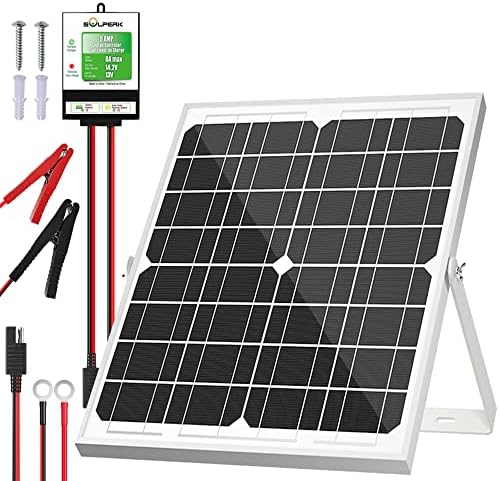### Solar Panel Types Explained: The Key Differences You Need to Know
I vividly remember the moment when we made the leap into renewable energy. We sat around our rustic table one evening, fueled by excitement and a bit of apprehension about the investment we were about to make. We researched, debated, and finally chose solar panels as our primary energy source. The freedom it provided was exhilarating! But, like many who step into the world of solar energy, we quickly discovered a vast array of options. Different types of solar panels all promised to turn sunlight into savings and sustainability. As we learned the nuances, we wanted to share the essentials about the various types so that your solar journey can be just as joyful and empowering.
—
### Understanding Solar Panel Types
Whether you’re considering solar energy for your home, cabin, or off-grid setup, understanding the types of solar panels available is essential. Each type comes with unique benefits and limitations, making it crucial to choose wisely based on your specific needs and setup. Below, we’ll break down three main types of solar panels: Monocrystalline, Polycrystalline, and Thin-Film.
#### 1. Monocrystalline Solar Panels
Monocrystalline solar panels are crafted from single-crystal silicon, giving them a distinct black color and unified aesthetic. Here are some key points to consider:
– **Efficiency**: These panels are typically the most efficient on the market, often achieving efficiencies between 15% to 22%. The higher efficiency means you’ll need fewer panels to meet your energy needs, which is especially beneficial if space is limited.
– **Longevity**: Monocrystalline panels have an impressive lifespan, often lasting 25 years or more. They also tend to come with longer warranties, reflecting their durability.
– **Temperature Performance**: They perform better in high temperatures compared to their counterparts, retaining efficiency even under the sweltering midday sun.
**Pros**:
– Sleek design
– High efficiency
– Long lifespan
**Cons**:
– More expensive upfront
– Less effective in partial shading conditions due to the higher efficiency of the individual cells.
#### 2. Polycrystalline Solar Panels
Polycrystalline solar panels are made from multiple silicon crystals melted together. This results in a speckled blue appearance. Here are the highlights:
– **Cost-Effective**: Generally cheaper than monocrystalline panels, polycrystalline panels can be an attractive option for budget-conscious buyers looking to set up solar energy without breaking the bank.
– **Efficiency**: While typically slightly less efficient (around 13% to 16%), they still offer a solid performance for homes that aren’t limited on space.
– **Easier to Produce**: The manufacturing process is simpler, contributing to lower costs, and it requires less energy to produce compared to monocrystalline.
**Pros**:
– Lower cost
– Affordable for larger installations
**Cons**:
– Slightly less efficient
– Space requirements may be greater as they typically yield less energy per panel than monocrystalline.
#### 3. Thin-Film Solar Panels
Thin-film solar panels are a newer technology made from layers of photovoltaic material on flexible substrates like glass, plastic, or metal. Here’s what to consider:
– **Flexibility**: These panels are lightweight and can be manufactured in a variety of shapes and sizes, making them ideal for unique installations.
– **Lower Efficiency**: Their efficiency tends to be lower (generally between 10% to 12%), meaning you’ll need more surface area to generate the same amount of power, which could be a limiting factor in certain setups.
– **Performance in Low Light**: One advantage of thin-film panels is that they can perform relatively well in low-light conditions, such as cloudy weather or shaded areas.
**Pros**:
– Lightweight and compact design
– Good performance in low-light conditions
**Cons**:
– Typically lower efficiency
– Shorter lifespan (around 10-20 years)
—
### Choosing the Right Solar Panel for Your Needs
When selecting a solar panel, it’s vital to assess your individual energy needs, budget, and space available for installation. Here are key considerations:
– **Energy Needs**: Calculate your average energy consumption to determine the panel output you need. The more you use, the more panels or higher-efficiency panels you’ll require.
– **Budget**: Start with a clear budget. Consider installation costs, as well as the potential for system savings over time.
– **Space**: Evaluate the area you have for installation. If you have ample roof space, you may opt for polycrystalline panels. For limited areas, monocrystalline panels may be ideal for their efficiency.
### Pro Tips for Solar Panel Success
1. **Research Reputable Brands**: Quality matters! Look for established companies with strong warranties and performance records. This often indicates reliability and customer satisfaction.
2. **Consider Installation Costs**: Solar panel costs don’t stop at purchase. Get multiple quotes for installation to ensure competitive pricing.
3. **Don’t Overlook Incentives**: Many states and federal programs offer tax incentives or rebates for going solar. Research these to lower your overall investment.
4. **Plan for Future Needs**: If you think your energy needs may increase (expanding family, electric vehicles, etc.), factor this into your decision.
5. **Optimal Placement**: Consult with professionals to determine the best placement for your panels. Proper angles and orientations can significantly improve efficiency.
### Conclusion
Embarking on a solar journey can seem daunting, but understanding the differences among solar panel types can empower you to make the best decision for your energy needs. Whether you opt for the high efficiency of monocrystalline, the budget-friendly polycrystalline, or the flexible design of thin-film panels, the key is to align your choice with your lifestyle, budget, and space. As you harness the sun’s energy, remember: every panel installed is a step toward a greener, more sustainable future!
By leveraging this knowledge, not only can you make an informed decision, but you can also embrace the exciting and liberating lifestyle that comes with solar energy. Here’s to bright, sunny days ahead!



